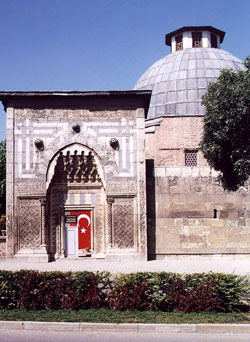|
Konya down-time In Konya, there wasn't much for an Istanbul person to do outside the Mevlana performances, which went on for a week. One day, Aka and I and some musician friends were chatting in a hotel room and I asked Aka if some transpositions were terribly difficult. A good ney player should be able to transpose at the wish of a vocal soloist who is to be accompanied. The ney player normally has only six finger holes and a thumb hole, with embouchure and partial holing gymnastics to find as many as two dozen or more discrete pitches per octave. Aka said, "Try me." I tried concocting what I imagined to be progressively more difficult transpositions, such as naming a composition in makam Evcara, with lots of sharps, and transposing it up a step and a half, or down three comas. Effortlessly and without hesitation, Aka aced all my challenges without breaking a sweat. On my wanderings about the historical city of Konya
This and other recordings I made of Aka are deposited in the Signell Collection at the American Folklife Center, Library of Congress in Washington, D.C.
|
